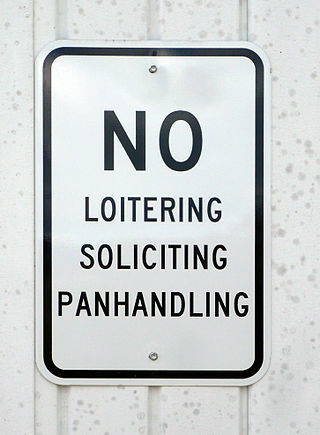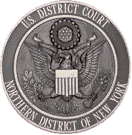
The Fourth Amendment to the United States Constitution is part of the Bill of Rights. It prohibits unreasonable searches and seizures. In addition, it sets requirements for issuing warrants: warrants must be issued by a judge or magistrate, justified by probable cause, supported by oath or affirmation, and must particularly describe the place to be searched and the persons or things to be seized.
In United States criminal law, probable cause is the standard by which police authorities have reason to obtain a warrant for the arrest of a suspected criminal or the issuing of a search warrant. There is no universally accepted definition or formulation for probable cause. One traditional definition, which comes from the U.S. Supreme Court's 1964 decision Beck v. Ohio, is when "whether at [the moment of arrest] the facts and circumstances within [an officer's] knowledge and of which they had reasonably trustworthy information [are] sufficient to warrant a prudent [person] in believing that [a suspect] had committed or was committing an offense."
The police procedural, police show, or police crime drama, is a subgenre of procedural drama and detective fiction that emphasizes the investigative procedure of police officers, police detectives, or law enforcement agencies as the protagonists, as contrasted with other genres that focus on non-police investigators such as private investigators.
Hiibel v. Sixth Judicial District Court of Nevada, 542 U.S. 177 (2004), is a United States Supreme Court case in which the Court held that a statute requiring suspects to disclose their names during a valid Terry stop does not violate the Fourth Amendment if the statute first requires reasonable suspicion of criminal involvement, and does not violate the Fifth Amendment if there is no allegation that their names could have caused an incrimination.
Disorderly conduct is a crime in most jurisdictions in the United States, the People's Republic of China, and Taiwan. Typically, "disorderly conduct" makes it a crime to be drunk in public, to "disturb the peace", or to loiter in certain areas. Many types of unruly conduct may fit the definition of disorderly conduct, as such statutes are often used as "catch-all" crimes. Police may use a disorderly conduct charge to keep the peace when people are behaving in a disruptive manner, but otherwise present no danger.
A Terry stop in the United States allows the police to briefly detain a person based on reasonable suspicion of involvement in criminal activity. Reasonable suspicion is a lower standard than probable cause which is needed for arrest. When police stop and search a pedestrian, this is commonly known as a stop and frisk. When police stop an automobile, this is known as a traffic stop. If the police stop a motor vehicle on minor infringements in order to investigate other suspected criminal activity, this is known as a pretextual stop. Additional rules apply to stops that occur on a bus.
A civil gang injunction or CGI is a type of restraining order issued by courts in the United States prohibiting gang members in particular cities from participating in certain specified activities. It is based on the legal theory that gang activity constitutes a public nuisance that can prevent non–gang members of the community from enjoying peace and public order. An injunction is obtained against the gang itself, after which the police and district attorney may decide against whom they will enforce it upon. Law enforcement use gang injunctions as a tool to label people as gang members and restrict their activities in a defined area (ACLU).

Loitering is the act of standing or waiting around idly without apparent purpose.
Kolender v. Lawson, 461 U.S. 352 (1983), is a United States Supreme Court case concerning the constitutionality of vague laws that allow police to demand that "loiterers" and "wanderers" provide "credible and reliable" identification.
City of Chicago v. Morales, 527 U.S. 41 (1999), is a United States Supreme Court case in which the Court held that a law cannot be so vague that a person of ordinary intelligence can not figure out what is innocent activity and what is illegal.
Brown v. Texas, 443 U.S. 47 (1979), was a United States Supreme Court case in which the Court determined that the defendant's arrest in El Paso, Texas, for a refusal to identify himself, after being seen and questioned in a high crime area, was not based on a reasonable suspicion of wrongdoing and thus violated the Fourth Amendment. It is an important case for Stop and Identify statutes in the United States.

The StingRay is an IMSI-catcher, a cellular phone surveillance device, manufactured by Harris Corporation. Initially developed for the military and intelligence community, the StingRay and similar Harris devices are in widespread use by local and state law enforcement agencies across Canada, the United States, and in the United Kingdom. Stingray has also become a generic name to describe these kinds of devices.
The stop-question-and-frisk program, or stop-and-frisk, in New York City, is a New York City Police Department (NYPD) practice of temporarily detaining, questioning, and at times searching civilians and suspects on the street for weapons and other contraband. This is what is known in other places in the United States as the Terry stop. The rules for the policy are contained in the state's criminal procedure law section 140.50 and based on the decision of the US Supreme Court in the case of Terry v. Ohio.

Floyd, et al. v. City of New York, et al., 959 F. Supp. 2d 540, is a set of cases addressing the class action lawsuit filed against the City of New York, Police Commissioner Raymond Kelly, Mayor Michael Bloomberg, and named and unnamed New York City police officers ("Defendants"), alleging that defendants have implemented and sanctioned a policy, practice, and/or custom of unconstitutional stops and frisks by the New York Police Department ("NYPD") on the basis of race and/or national origin, in violation of Section 1983 of title forty-two of the United States Code, the Fourth and Fourteenth Amendments to the United States Constitution, Title VI of the Civil Rights Act of 1964, and the Constitution and laws of the State of New York.
Racial profiling by law enforcement at the local, state, and federal levels, leads to discrimination against people in the African American, Native American, Asian, Pacific Islander, Latino, Arab, and Muslim communities of the United States. Examples of racial profiling are the use of race to determine which drivers to stop for minor traffic violations, or the use of race to determine which pedestrians to search for illegal contraband. Besides such disproportionate searching of African Americans and members of other minority groups, other examples of racial profiling by law enforcement in the U.S. include the Trump-era China Initiative following racial profiling against Chinese American scientists; the targeting of Hispanic and Latino Americans in the investigation of illegal immigration; and the focus on Middle Eastern and South Asians present in the country in screenings for ties to Islamic terrorism. These suspicions may be held on the basis of belief that members of a target racial group commit crimes at a higher rate than that of other racial groups.

Homelessness in the United States has occurred to varying degrees across the country. The total number of homeless people in the United States fluctuates and constantly changes hence a comprehensive figure encompassing the entire nation is not issued since counts from independent shelter providers and statistics managed by the United States Department of Housing and Urban Development vary greatly. Federal HUD counts hover annually at around 500,000 people. Point-in-time counts are also vague measures of homeless populations and are not a precise and definitive indicator for the total number of cases, which may differ in both directions up or down. The most recent figure for the year 2019 that was given was at 567,715 individuals across the country that have experienced homelessness at a point in time during this period.

Brown v. City of Oneonta was a case brought to the U.S District Court for the Northern District of New York in 1993 and later appealed to the United States Court of Appeals for the Second Circuit in 1999 that concerned the use of race in law enforcement investigations.

The New York City Police Department (NYPD) actively monitors public activity in New York City, New York, United States. Historically, surveillance has been used by the NYPD for a range of purposes, including against crime, counter-terrorism, and also for nefarious or controversial subjects such as monitoring political demonstrations, activities, and protests, and even entire ethnic and religious groups.

The New York City Police Department Intelligence Bureau is a division of the New York City Police Department (NYPD) which claims responsibility for the detection and disruption of criminal and terrorist activity through the use of intelligence-led policing. There is limited oversight over the Intelligence Bureau, and it conducts work in secrecy without the city council being informed of operations.
A reverse search warrant is a type of search warrant used in the United States, in which law enforcement obtains a court order for information from technology companies to identify a group of people who may be suspects in a crime. They differ from traditional search warrants, which typically apply to specific individuals. Geo-fence warrants, which seek data on mobile phone users who were in a specific location at a given time, and keyword warrants, which request information on users who searched specific phrases, are two types of reverse search warrants.







